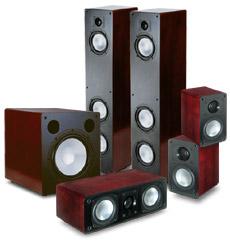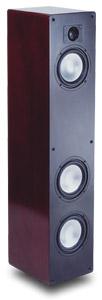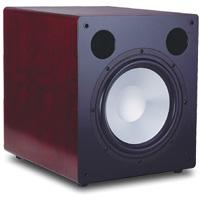
RBH MC-Series Home Theater Speaker System
By Jeff Van Dyne

Description
Model:
MC-6CT speakers
Price:
$999 USD per pair
Dimensions:
40"H x 8.75"W x 12"D
Weight:
45 pounds each
Model:
MC-414C center-channel speaker
Price:
$379 USD
Dimensions:
6.5"H x 14.5"W x 9.5"D
Weight:
13 pounds
Model:
MC-4C surround speakers
Price:
$399 USD per pair
Dimensions:
6.5"H x 9"W x 7"D
Weight:
8 pounds each
Model:
TS-12AP subwoofer
Price:
$849 USD
Dimensions:
18.75"H x 16"W x 18.75"D
Weight:
60 pounds
System Price:
$2626 USD in standard finish
Warranty:
Five years parts and labor
Features
- 6.5" aluminum-cone woofers and midrange (MC-6CT)
- 4" aluminum-cone woofer(s) (MC-414C, MC-4C)
- 1" aluminum-dome tweeter (MC-6CT, MC-414C, MC-4C)
- Gold-plated binding posts (all speakers, dual on MC-6CT)
- Magnetically shielded (MC-6CT, MC-414C, MC-4C)
- 12" aluminum-cone woofer (TS-12A)
- Variable volume and crossover (TS-12A)
- Phase switch (TS-12A)
- Auto on/off (TS-12A)
- 180W built-in amplifier (TS-12A)
- Low- and high-level inputs (TS-12A)
- Black ash standard with optional finishes cherry and white available (optional finishes have additional cost)
 I’ve
barely finished watching The Contender on DVD and now Patton is on in
the background. I’m supposed to be reviewing the home-theater speaker
system from RBH Audio, but I can’t seem to focus on the speakers. I go
back through my listening notes — and there aren’t many, these speakers
have been in the house for weeks now.
I’ve
barely finished watching The Contender on DVD and now Patton is on in
the background. I’m supposed to be reviewing the home-theater speaker
system from RBH Audio, but I can’t seem to focus on the speakers. I go
back through my listening notes — and there aren’t many, these speakers
have been in the house for weeks now.
The simple truth is that I keep paying attention to the movies, not the review. Even at this instant, I’m being drawn into the picture — and I'm on a deadline here. It’s not like I haven’t seen this movie before.
OK, so I’ll turn off the movie and write for a while.
Of course, I’ve been aware of RBH for some time. Named after chief designer Roger B. Hassing, the company has been making loudspeakers since 1976, featuring — no, making a trademark out of — gleaming aluminum drivers, eye-catching colors and luxurious veneer finishes of the sort people expect from the high-priced brands. Then, back in January, I dropped in on the RBH booth at the 2001 CES, and I was impressed at what I saw and heard.
The speakers
 From
the moment I unboxed the MC system, it was apparent that it might be
something special. The speakers are finished in an extremely attractive
dark-cherry-stained veneer veneer with a high-gloss lacquer finish. The
MC-6CT towers aren’t particularly heavy, but they seem well made and
sport solidly constructed, gold-plated, dual binding posts. As for the
metal drivers, they look as cool in person as they did in the
literature. I couldn't stop myself — I immediately plugged everything in
and dropped a movie into the DVD player just to satisfy my intense
curiosity. Just how cool were they?
From
the moment I unboxed the MC system, it was apparent that it might be
something special. The speakers are finished in an extremely attractive
dark-cherry-stained veneer veneer with a high-gloss lacquer finish. The
MC-6CT towers aren’t particularly heavy, but they seem well made and
sport solidly constructed, gold-plated, dual binding posts. As for the
metal drivers, they look as cool in person as they did in the
literature. I couldn't stop myself — I immediately plugged everything in
and dropped a movie into the DVD player just to satisfy my intense
curiosity. Just how cool were they?
First, a few details about the speakers. The system reviewed here consists of two MC-6CTs — a four-driver three-way tower speaker with one aluminum-dome tweeter and three 6.5" aluminum drivers, a midrange and two woofers, which cross over at 100Hz and 3kHz; the MC-414C center, a shielded two-way speaker with an aluminum-dome tweeter and two smaller 4" drivers crossed over at 4kHz; a pair of MC-4C surrounds, a two-way bookshelf speaker with the same driver compliment as the center minus one woofer; and a TS-12AP subwoofer with a ported 12" aluminum-cone woofer and a built-in 180W amplifier. The cabinets were well built from MDF and covered in handsome cherry veneer finished to a high gloss. All of the speakers, except the sub, were sealed enclosures and all boasted RBH's "aimable" tweeter and steep crossovers. Total cost for the version I auditioned in cherry is $2982 ($2626 in black).
The MC-6CTs are a nice size without looking the least bit imposing at 40"H x 8.75"W x 12"D, and their elegant finish certainly helps them blend in with the decor. They look cool without the grilles in place, though that does draw a bit more attention to them — a no-no if you’re trying to hide them from the decorator. The MC-414C center is a bit on the smallish side compared to the towers, at 6.5"H x 14.5"W x 9.5"D, but its output doesn’t seem to suffer because of it. The surrounds — the MC-4C bookshelf speakers — are a good match for the mains. The TS-12AP is a medium-sized ported subwoofer with all the standard functions: a rear-mounted amplifier/interface complete with an auto on/off (which was a little too quick to shut off at low volume levels, in my experience), phase-reversal switch, variable crossover and gold-plated line- and speaker-level inputs and outputs. Basically, it has everything you need but nothing out of the ordinary — other than that large aluminum cone on the front of the box, that is.
The setup
Setup was simple. I dropped the towers into the approximate locations where my Silverline Sonatinas normally reside, placed the center atop the TV and mounted the surrounds on high stands to the sides of the room. Everything sounded great right out of the boxes and, while I certainly tried to find better locations for the individual speakers, I never succeeded in substantially bettering my original positions. They don’t seem terribly picky about where you put them. I even pushed them all the way back against the wall. The image and soundstage collapsed, of course, and the tonal balance was affected, but even this deliberate misplacement didn't destroy their essential qualities. If you’re dealing with tight placement restrictions, the RBHs might make a superb choice.
The sound
Normally, I would give a new set of speakers at least 20 or 30 hours of break-in before doing any critical listening, but such was my state of mind that I immediately dropped U-571 into the DVD player and let the depth charges fly! That probably wasn’t fair, but what the hell — as long as I was going to give them a serious test without a chance to break in, I might as well stress them a little. Whew! The walls shook and the dog ran upstairs to hide in the bedroom. Poor thing, he absolutely hates it when I demo that movie.
Telarc’s 1812 Overture [Telarc CD-80541] didn’t send subwoofer parts flying across the room or cause any discontinuities with the mains. Not that I was expecting any, but a home-theater system has to be able to take a little abuse. The RBH system could play loud — excessively, even — without strain.
The MC-6CT's detail and imaging are as good as, or better than, any tower I’ve heard in this price range. If you’ve heard the Monitor Audio Silver 5i speakers, then think along those lines: clean and just a little to the bright side of neutral, but warmer and with better dynamics. They’re also taller than the Monitor Audios, which puts their image height about where it should be. Musical detail was surprisingly good, bettering my Silverline Sonatinas (original version) at the low end while not quite matching them in the midrange and high end.
When it came to transient response, the MC-6CT turned in a stunning performance at less than a third of the price of the Sonatinas. The Sonatina is cleaner in the upper octaves and seems happier with classical and jazz, while the RBH is the better rock speaker of the two. Now, I’m not saying the RBH is a better speaker than the Sonatina, but its bass is tighter and tauter. On the other hand, I felt the Silverline ultimately gave that last bit of resolution and low-level detail. The RBHs compared favorably to my references — especially considering their more than reasonable price.
 And
then there’s the TS-12AP. I can be incredibly picky about bass and
would rather live without it than endure bad bass. I can live with most
subs for the course of a review but for my own system the bass must be
tight and clean.
And
then there’s the TS-12AP. I can be incredibly picky about bass and
would rather live without it than endure bad bass. I can live with most
subs for the course of a review but for my own system the bass must be
tight and clean.
I’m so anal-retentive about bass that a couple of years ago, when I was significantly more fiscally challenged than I am today, I judged all the subs in my price range to be unsuitable for human consumption and built my own. This large sealed design, based on ACI’s SV-12 woofer and PSA-1 amp, has been the happy mainstay in my system ever since, and I’ve yet to hear anything under a grand that was as clean.
Until now, that is. The TS-12AP has dethroned my own sub. It plays cleaner, tighter, louder, lower, and it’s about half the size to boot.
My classic music test for a subwoofer has always been "Hotel California" from the Eagles' Hell Freezes Over DVD. With the RBH, the kick drum was tight with just a tad of resonance and was able to pretty much vibrate everything in the room without becoming boomy. Yet, it didn’t overwhelm the acoustic guitar or snare drum.
Through the MC-6CTs, instruments were accurately placed within the expansive soundstage and the vocals were cleanly articulated. In addition to the TS-12AP's spectacular bottom-end performance, the overall sound was well integrated and controlled. To say that I was impressed would be an understatement of monumental proportions. I think I’ve found a new friend. (The dog, on the other hand, isn’t so happy.
I was more than pleased with the RBH system on music, but it absolutely excelled on movies. Dialogue was always clear and voices were well placed within the soundfield. The MC-414C is on par with the JMlab CC-700 center I reviewed earlier in the year — a model of dialogue clarity. JMlab's center is slightly better than the RBH at portraying dynamic swings, but the RBH is superior where absolute clarity and transient response are concerned. Still, it must also be said that the CC-700 was a closer tonal match to the 715s than the MC-414C was to the MC-6CTs.
I found that I tended to ignore the surrounds. They did the job they were supposed to do and blended in seamlessly with the mains and center. When they were called on to do more than background work, they were more than up to the task.
During the dance sequence in chapter 3 of Mission: Impossible 2, the beat of the dancer's shoes against the veneeren floor was powerful without being boomy. Some of the lesser systems I’ve had through here lately were a little distracting on this passage, but the RBH system captured the direct sound and the room's acoustic in a markedly natural way. In Starship Troopers, the attack on Klendathu may have failed, but the RBH system never showed any signs of weakness through countless explosions and gunfire. As the bugs attacked, I sensed not only the massed hordes in the background but also the low-level sound of several distinct bugs near and around me.
As for lighter fare, at least where sound effects are concerned, much of the movie Pleasantville involves subtle background noises, which are used to create the canvas on which the story is told. From the birds chirping in the background to the sounds of thunder, wind and rain, all of the elements were perfectly placed and articulately rendered to make this modern fairy tale come to life.
There just wasn't much to complain about as far as performance was concerned. At high SPLs, the system gets a tad bright with a hint of harshness, but that could be the sound of my Rotel RB-976 topping out. On the plus side, the system has impressive dynamics, excellent detail, and some of the best bass quality I’ve heard anywhere approaching its price. It gives up very little when compared with my drastically more expensive Silverline Sonatinas, save for that last smidge of resolution and upper-octave detail — stunning performance for a six-speaker system retailing for $1000 less than the Silverline stereo pair. As a matter of fact, I preferred the RBH system to the Sonatinas when it came to movie sound — the system would probably still be a contender at twice its price.
In comparison to the slightly less expensive JMlab Chorus system I previously reviewed for HT&S, the RBH system is similar, but less bright overall, while remaining a little more forward through the midrange. As previously stated, the center-channel speakers are similar, even though each does some things better than the other. The MC-6CTs rival the 715s in dynamics, but are significantly clearer overall and more open. Then there’s the TS-12AP, which is a significantly larger ported design than the JMlab model. I expected the RBH to surrender some degree of sonic detail to the JMlab here, but I was wrong. The RBH clearly possesses better bass extension, improved dynamics, and increased detail and control. The sub still won’t buy you that last half octave or so of bass extension but it will get you very close.
Conclusion
If you will be using the system primarily for movies and rock music, the RBH MC system should be a perfect fit. Even if you listen to a lot of jazz and classical, it should still be on your short list, since its sins are primarily those of omission and are easy to ignore. Only when directly compared to much more expensive loudspeakers did the system manifest any significant shortcomings. And, even then, only in specific areas of music reproduction.
RBH's MC-Series home-theater speaker system seems to have it all: terrific detail, stunning bass quality, excellent dynamics and a handsome finish to boot. All things considered, it just may represent one of the best home-theater values I’ve come across in a very long time.
Now, if you’ll excuse me, I have a movie to get back to.
Review System
Receiver/processor
– Sherveneer Newcastle R-925 (only used as a processor)
Amplifiers
– Rotel RB-976
Sources
– Sony DVP-S300 DVD player, Adcom GCD-600 CD player
Monitor
– Proscan 35" direct-view monitor
Manufacturer contact information:
RBH Sound, Inc.
Layton, UT 84041
Phone: (801) 543-2200
E-mail: info@rbhsound.com
Website: www.rbhsound.com